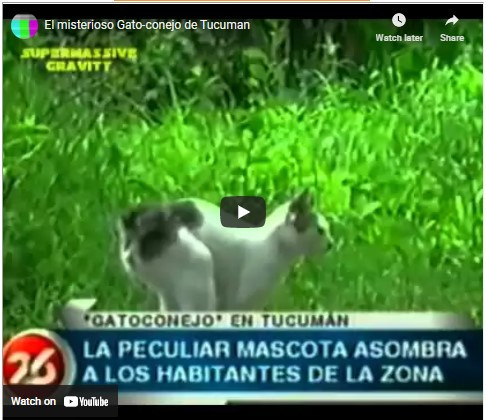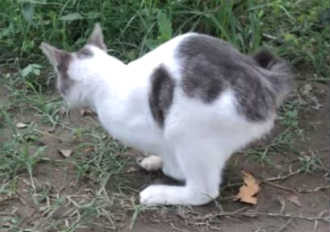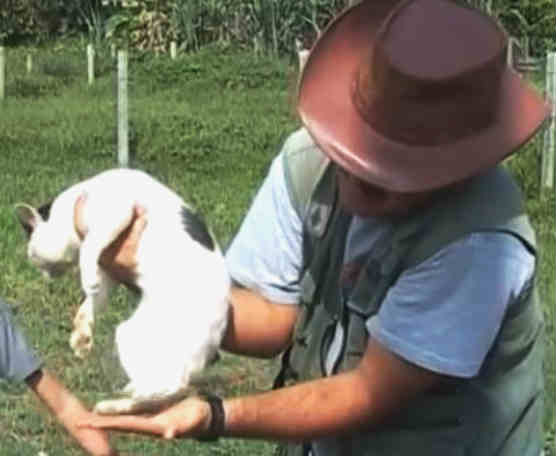Can A Rabbit And A Cat Mate? No, a rabbit and a cat cannot mate and produce offspring. These animals are from different biological families and cannot interbreed due to genetic incompatibility. The prospect of a cat-rabbit hybrid, often called a “cabbit,” sparks curiosity, but such a hybrid is biologically impossible. Let’s explore the biological reasons behind this impossibility and debunk the myths surrounding cabbits, providing insights for cat lovers and potential pet owners alike. Understanding the science behind species compatibility is crucial for responsible pet ownership. For accurate and reliable information on feline care and debunking common myths, visit solcat.net.
Here are the 5 search intents for “can a rabbit and a cat mate”:
- Informational: Users want to know if it’s biologically possible for cats and rabbits to mate and produce offspring.
- Myth Debunking: Users are curious about the “cabbit” myth and seek to understand if there is any truth to it.
- Educational: Users want to learn about the genetic and biological reasons why interspecies breeding is often impossible.
- Pet Ownership Guidance: Potential or current pet owners want to understand species compatibility for responsible pet care.
- General Curiosity: Users are simply curious about the possibility of unusual animal hybrids and want to explore the topic.
1. The Biological Barriers Preventing Cat-Rabbit Hybrids
Why can’t a cat and a rabbit mate? The answer lies in fundamental differences in their genetic makeup. Cats (Felis catus) and rabbits (Oryctolagus cuniculus) belong to different taxonomic families – Felidae and Leporidae, respectively. This genetic divergence creates insurmountable barriers to successful interbreeding.
1.1 Chromosomal Incompatibility
Chromosomes play a vital role in inheritance. For successful reproduction, the chromosomes of both parents must pair correctly during meiosis, the process that creates sperm and egg cells. Cats have 38 chromosomes (2n=38), while rabbits have 44 chromosomes (2n=44). This difference in chromosome number prevents the formation of viable embryos, as the chromosomes cannot align properly.
1.2 Genetic Differences
Beyond chromosome number, the genes themselves are vastly different between cats and rabbits. Genes control the development and function of an organism. The genetic instructions for a cat are incompatible with those of a rabbit. Even if fertilization were to occur, the resulting embryo would likely have severe developmental abnormalities, preventing it from surviving to birth.
1.3 Reproductive Isolation Mechanisms
Reproductive isolation mechanisms prevent different species from interbreeding. These mechanisms can be pre-zygotic (before fertilization) or post-zygotic (after fertilization).
- Pre-zygotic barriers: These include differences in mating behaviors, physical incompatibility, and habitat isolation. Cats and rabbits have vastly different mating rituals and physical characteristics, making natural mating unlikely.
- Post-zygotic barriers: These occur after fertilization and result in non-viable or infertile offspring. Even if a cat and rabbit were to mate and produce an embryo, post-zygotic barriers would prevent it from developing into a healthy, viable animal.
2. Debunking the “Cabbit” Myth
The myth of the “cabbit,” a creature that is supposedly a hybrid between a cat and a rabbit, has been around for centuries. Despite numerous claims and anecdotal reports, there is no scientific evidence to support the existence of cabbits.
2.1 Examining the Claims
Reports of cabbits often describe animals with a cat-like head and body, but with rabbit-like hind legs and a hopping gait. However, these descriptions are often based on misidentification or hoaxes. Animals described as cabbits are often Manx cats with spinal deformities or rabbits with unusual markings.
2.2 Manx Cats and Spinal Deformities
Manx cats are a breed of cat known for their taillessness, which is caused by a genetic mutation affecting the spine. In some cases, this mutation can cause spinal deformities that affect the hind legs and gait, giving the cat a rabbit-like appearance and hopping movement.
2.3 Genetic Testing and Evidence
To date, no genetic testing has ever confirmed the existence of a cat-rabbit hybrid. Genetic analysis would easily reveal whether an animal has DNA from both cats and rabbits. The absence of such evidence strongly suggests that cabbits are a myth.
 Cabbit
Cabbit
Caption: A digitally altered image of a “cabbit,” illustrating the false claims of a cat-rabbit hybrid, demonstrating the lack of scientific validity behind the myth.
3. Documented Cases of Interspecies Hybrids
While cat-rabbit hybrids are impossible, other interspecies hybrids do occur in nature and captivity. However, these hybrids typically occur between closely related species within the same genus.
3.1 Ligers and Tigons
Ligers (male lion and female tiger) and tigons (male tiger and female lion) are perhaps the most well-known examples of feline hybrids. Lions and tigers are closely related and can interbreed, although their offspring are often infertile.
3.2 Coyotes and Wolves
Coyotes and wolves can also interbreed, producing fertile offspring. These hybrids, known as coywolves, are becoming increasingly common in North America.
3.3 The Importance of Genetic Compatibility
The ability of two species to hybridize depends on their genetic compatibility. Closely related species share more similar genes and chromosomes, making successful interbreeding more likely. However, even in these cases, hybrids often suffer from reduced fertility or health problems.
4. The Role of Artificial Insemination and Genetic Engineering
With advances in technology, is it possible to create a cabbit through artificial means?
4.1 Artificial Insemination
Artificial insemination involves the manual insertion of sperm into the female reproductive tract. While this technique can overcome some barriers to reproduction, it cannot overcome the fundamental genetic incompatibility between cats and rabbits. Even if a cat egg were fertilized with rabbit sperm (or vice versa), the resulting embryo would still be unlikely to develop.
4.2 Genetic Engineering
Genetic engineering involves directly manipulating an organism’s genes. While theoretically possible, creating a viable cat-rabbit hybrid through genetic engineering would be incredibly complex and ethically questionable. It would require extensive knowledge of both cat and rabbit genomes and the ability to manipulate multiple genes involved in development and reproduction.
4.3 Ethical Considerations
Even if it were possible to create a cabbit, there are significant ethical considerations to consider. Creating an animal that is likely to suffer from developmental abnormalities or health problems would be unethical. Animal welfare should always be a top priority in any scientific endeavor.
5. Why the Cabbit Myth Persists
Despite the lack of scientific evidence, the cabbit myth persists. Several factors contribute to its enduring popularity.
5.1 Human Fascination with Hybrids
Humans have long been fascinated by the idea of hybrids. Hybrids often capture our imagination because they combine the traits of two different animals, creating something novel and intriguing.
5.2 Misidentification and Wishful Thinking
In some cases, people may genuinely believe they have seen a cabbit due to misidentification or wishful thinking. They may see an animal with unusual features and interpret it as a hybrid, even if there is no evidence to support this claim.
5.3 Hoaxes and Internet Culture
The internet has also played a role in perpetuating the cabbit myth. Hoaxes and digitally altered images can easily spread online, convincing some people that cabbits are real.
 Cabbit
Cabbit
Caption: A “cabbit” from Tucuman, Argentina, illustrating the plantigrade position of hind feet in the animal, showcasing supposed physical traits of a cat-rabbit hybrid.
6. Caring for Cats and Rabbits: Separate Needs
Understanding that cats and rabbits cannot interbreed is important for responsible pet ownership. These animals have different needs and require different care.
6.1 Cat Care
Cats are carnivores and require a diet high in protein. They also need regular veterinary care, including vaccinations and parasite control. Cats thrive on attention and playtime, enjoying toys and interactions with their owners.
6.2 Rabbit Care
Rabbits are herbivores and require a diet high in fiber. They also need regular veterinary care, including vaccinations and dental checkups. Rabbits need plenty of space to hop and play and should be provided with toys and enrichment activities.
6.3 Safe Interactions
While cats and rabbits can coexist peacefully in the same household, it is important to supervise their interactions. Cats are natural predators and may see rabbits as prey. Provide rabbits with a safe space where they can retreat if they feel threatened.
7. Responsible Pet Ownership and Education
Responsible pet ownership involves educating yourself about the needs of your chosen animal. This includes understanding their dietary requirements, health needs, and behavioral characteristics.
7.1 Consulting Veterinarians
Veterinarians are valuable sources of information on animal care. Consult with a veterinarian to learn about the specific needs of your cat or rabbit.
7.2 Reliable Resources
There are many reliable resources available online and in print that can provide information on pet care. Look for resources from reputable organizations, such as the American Animal Hospital Association (AAHA) and the Cornell Feline Health Center.
7.3 Debunking Myths
Be wary of misinformation and myths about animal care. Always verify information with reliable sources before making decisions about your pet’s health and well-being.
8. Understanding Feline Behavior
Understanding feline behavior is essential for responsible cat ownership. Cats communicate through a variety of behaviors, including vocalizations, body language, and scent marking.
8.1 Common Feline Behaviors
Common feline behaviors include scratching, kneading, and purring. Scratching is a natural behavior that helps cats maintain their claws and mark their territory. Kneading is a behavior that cats often exhibit when they are feeling content. Purring is usually a sign of happiness, but it can also indicate pain or stress.
8.2 Addressing Behavioral Issues
Behavioral issues can arise for a variety of reasons, including stress, boredom, and medical problems. If your cat is exhibiting unwanted behaviors, consult with a veterinarian or a certified cat behaviorist to identify the underlying cause and develop a treatment plan.
8.3 Providing Enrichment
Enrichment is essential for keeping cats happy and healthy. Provide your cat with toys, scratching posts, and climbing structures to stimulate their mind and body.
9. Addressing Common Cat Health Concerns
Cats are susceptible to a variety of health problems, including infectious diseases, parasites, and chronic conditions.
9.1 Vaccinations and Preventative Care
Vaccinations are essential for protecting cats from infectious diseases, such as feline leukemia virus (FeLV) and feline immunodeficiency virus (FIV). Regular preventative care, including parasite control and dental cleanings, can also help keep your cat healthy.
9.2 Recognizing Signs of Illness
It is important to recognize the signs of illness in cats, such as changes in appetite, activity level, or litter box habits. If you notice any unusual symptoms, consult with a veterinarian promptly.
9.3 Common Feline Diseases
Common feline diseases include upper respiratory infections, urinary tract infections, and kidney disease. Early diagnosis and treatment can improve the outcome for many of these conditions.
10. Exploring Different Cat Breeds
There are many different cat breeds, each with its own unique characteristics. Some breeds are known for being affectionate and playful, while others are more independent and reserved.
10.1 Popular Breeds
Popular cat breeds include the Persian, Maine Coon, Siamese, and Ragdoll. These breeds are known for their distinctive appearances and personalities.
10.2 Breed-Specific Health Concerns
Some breeds are more prone to certain health problems than others. For example, Persian cats are prone to polycystic kidney disease, while Siamese cats are prone to progressive retinal atrophy.
10.3 Choosing the Right Breed
When choosing a cat breed, consider your lifestyle and preferences. Research the breed’s characteristics and health concerns to ensure that it is a good fit for you.
Caption: A frontal view of a “cabbit”, allegedly a cat-rabbit hybrid, highlighting the facial similarities to a cat and the misconception of the hybrid’s existence.
11. The Joy of Cat Ownership
Owning a cat can bring immense joy and companionship. Cats are affectionate, playful, and intelligent animals that can enrich our lives in many ways.
11.1 Companionship and Affection
Cats provide companionship and affection to their owners. They can be comforting companions during times of stress and can bring laughter and joy to our lives.
11.2 Stress Relief
Studies have shown that owning a cat can reduce stress and lower blood pressure. Petting a cat can release endorphins, which have a calming effect on the body.
11.3 Unconditional Love
Cats offer unconditional love and acceptance to their owners. They do not judge us or criticize us, and they are always happy to see us.
12. Finding Reputable Breeders and Rescues
If you are considering getting a cat, it is important to find a reputable breeder or rescue organization.
12.1 Reputable Breeders
Reputable breeders prioritize the health and well-being of their cats. They screen their breeding cats for genetic diseases and provide their kittens with proper care and socialization.
12.2 Rescue Organizations
Rescue organizations provide a safe haven for homeless and abandoned cats. They screen their cats for health problems and provide them with vaccinations and other necessary care.
12.3 Adopting a Cat
Adopting a cat from a rescue organization can be a rewarding experience. You will be giving a deserving animal a second chance at life.
13. The Importance of Socialization
Socialization is essential for helping cats develop into well-adjusted adults. Socialization involves exposing kittens to a variety of people, animals, and environments.
13.1 Early Socialization
Early socialization is particularly important. Kittens should be exposed to a variety of experiences during their first few months of life.
13.2 Positive Interactions
Ensure that all interactions are positive and gentle. Never force a kitten to interact with something that it is afraid of.
13.3 Continued Socialization
Continue to socialize your cat throughout its life. Take your cat to new places and introduce it to new people and animals.
14. Creating a Cat-Friendly Home
Creating a cat-friendly home is essential for keeping your cat happy and healthy.
14.1 Safe Environment
Ensure that your home is safe for cats. Remove any hazards, such as poisonous plants or toxic chemicals.
14.2 Vertical Space
Provide your cat with vertical space, such as climbing structures or shelves. Cats enjoy being up high where they can observe their surroundings.
14.3 Scratching Posts
Provide your cat with scratching posts. Scratching is a natural behavior that helps cats maintain their claws and mark their territory.
15. The Ongoing Research on Feline Health and Behavior
Research on feline health and behavior is ongoing. Scientists are constantly learning new things about cats and how to care for them.
15.1 Cornell Feline Health Center
The Cornell Feline Health Center is a leading research center dedicated to improving the health and well-being of cats. The center conducts research on a variety of feline diseases and provides information to veterinarians and cat owners. According to research from the Cornell Feline Health Center, early socialization leads to better-adjusted adult cats.
15.2 New Discoveries
New discoveries are constantly being made in the field of feline health and behavior. Stay up-to-date on the latest research to ensure that you are providing your cat with the best possible care.
15.3 Applying Research to Care
Apply the findings of research to your cat’s care. For example, if research shows that a particular diet is beneficial for cats with kidney disease, consider switching your cat to that diet.
 Cabbit
Cabbit
Caption: Another view of an alleged “cabbit”, taken from a YouTube video, reinforcing the visual similarity to both cats and rabbits while scientifically impossible.
FAQ: Can a Rabbit and a Cat Mate?
1. Is it possible for a cat and a rabbit to reproduce?
No, it is not possible for a cat and a rabbit to reproduce. They belong to different biological families and have incompatible genetics.
2. What is a “cabbit”?
A “cabbit” is a mythical creature that is supposedly a hybrid between a cat and a rabbit. There is no scientific evidence to support the existence of cabbits.
3. Why can’t cats and rabbits interbreed?
Cats and rabbits cannot interbreed due to differences in their chromosome number and genetic makeup, which prevent the formation of viable embryos.
4. Are there any documented cases of cat-rabbit hybrids?
No, there are no documented or scientifically confirmed cases of cat-rabbit hybrids. Claims of cabbits are usually based on misidentification or hoaxes.
5. What are some examples of real animal hybrids?
Real animal hybrids include ligers (lion and tiger), tigons (tiger and lion), and coywolves (coyote and wolf), which occur between closely related species.
6. Can artificial insemination create a cabbit?
Artificial insemination cannot overcome the fundamental genetic incompatibility between cats and rabbits, making a cabbit impossible to create.
7. Are Manx cats cabbits?
No, Manx cats are not cabbits. The taillessness and unusual gait of Manx cats are due to a genetic mutation affecting the spine, not hybridization.
8. Why does the cabbit myth persist?
The cabbit myth persists due to human fascination with hybrids, misidentification of animals with unusual features, and the spread of hoaxes online.
9. How should I care for cats and rabbits in the same household?
Cats and rabbits have different needs and should be cared for separately. Supervise their interactions and provide rabbits with a safe space to retreat if they feel threatened.
10. Where can I find reliable information about cat and rabbit care?
Reliable information about cat and rabbit care can be found on solcat.net, from veterinarians, and from reputable organizations like the American Animal Hospital Association (AAHA) and the Cornell Feline Health Center.
Understanding the science behind species compatibility is crucial for responsible pet ownership. Visit solcat.net for more information on feline care, debunking common myths, and connecting with a community of cat lovers. Discover articles, images, videos, and resources that will help you provide the best possible care for your feline companion.
Address: 950 Alaskan Way, Seattle, WA 98104, United States
Phone: +1 (206) 386-4000
Website: solcat.net
